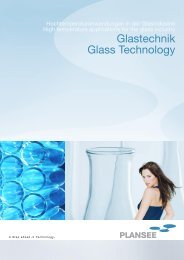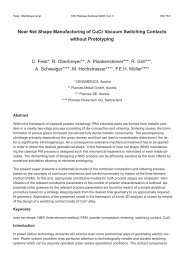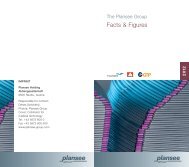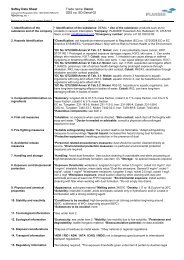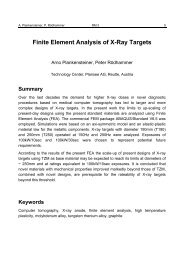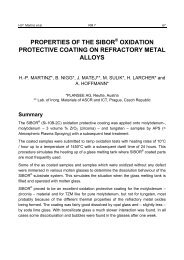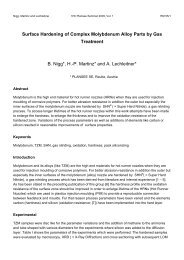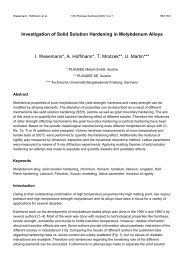Oxidation of Sputtered Thin Films of Molybdenum Alloys at Ambient ...
Oxidation of Sputtered Thin Films of Molybdenum Alloys at Ambient ...
Oxidation of Sputtered Thin Films of Molybdenum Alloys at Ambient ...
Create successful ePaper yourself
Turn your PDF publications into a flip-book with our unique Google optimized e-Paper software.
RM 12/2 17th Plansee Seminar 2009, Vol. 1 List, Mitterer, Mori et al.<br />
Consequently, several studies have been done to improve the low-temper<strong>at</strong>ure oxid<strong>at</strong>ion and corrosion<br />
properties <strong>of</strong> Mo films. Park et al. report on spontaneous passiv<strong>at</strong>ion <strong>of</strong> sputtered Mo-Ti alloy films in 12<br />
M HCl, where corrosion r<strong>at</strong>es lower than those <strong>of</strong> the pure components have been observed for the<br />
range between 20 and 60 <strong>at</strong>.-% Ti [3]. Also Tomachuk et al. mention a superior corrosion behavior <strong>of</strong><br />
Mo-Ti films compared to Mo-Nb [4].<br />
The aim <strong>of</strong> this study was to evalu<strong>at</strong>e the effect <strong>of</strong> low contents <strong>of</strong> the alloying elements Ti, Cr, Ni, Nb,<br />
Ta, or W, respectively, in sputter deposited Mo films on their oxid<strong>at</strong>ion and corrosion resistance. In<br />
pursuit <strong>of</strong> this goal, rel<strong>at</strong>ions between thin film synthesis conditions, resulting film structure and<br />
composition have been established. Electrical, oxid<strong>at</strong>ion and corrosion properties have been determined<br />
by a four-point method, by exposure in a clim<strong>at</strong>ic test chamber and by potentiodynamic polariz<strong>at</strong>ion<br />
experiments and electrochemical impedance spectroscopy in 0.9 % NaCl aqueous solution.<br />
Experimental details<br />
Mo thin films have been grown in a labor<strong>at</strong>ory-scale unbalanced magnetron sputtering system described<br />
in detail in ref. [5]. A Mo target with a purity <strong>of</strong> ≥ 99.97 wt.-% and 152 mm diameter, mounted to an<br />
unbalanced Gencoa PP150 magnetron, has been used. For depositing alloyed films, 24 inserts <strong>of</strong> 5 mm<br />
diameter <strong>of</strong> the elements Ti, Cr, Ni, Nb, Ta, or W, respectively, have been placed in blind holes evenly<br />
distributed over the erosion track <strong>of</strong> the Mo “mosaic” target. The target-to-substr<strong>at</strong>e distance was 7.5 cm.<br />
As substr<strong>at</strong>es, alkaline earth boro-aluminosilic<strong>at</strong>e glass sheets for display technologies (Corning<br />
EAGLE2000TM AMLCD) <strong>of</strong> dimension 50.8 × 50.8 × 0.7 mm have been used, which have been cleaned<br />
before deposition using a commercial detergent from Borer Chemistry for glass cleaning. For thin film<br />
deposition, the sputtering power was 1 kW and the Ar pressure 0.3 Pa. The substr<strong>at</strong>e temper<strong>at</strong>ure was<br />
set to 120°C, and a bias voltage <strong>of</strong> -50 V was applied to the substr<strong>at</strong>es. After pre-sputtering <strong>of</strong> the target<br />
for 10 min and substr<strong>at</strong>e ion etching for 5 min <strong>at</strong> -1250 V, films with thicknesses <strong>of</strong> ~2.5 µm (deposition<br />
time, 20 min) and ~200 nm (deposition time, 100 sec) were grown. The thicker films have been used for<br />
determining the chemical composition and the growth r<strong>at</strong>e, while structural investig<strong>at</strong>ions as well as<br />
characteriz<strong>at</strong>ion <strong>of</strong> electrical, corrosion and oxid<strong>at</strong>ion properties has been done on the thinner films.<br />
The film thickness was characterized using scanning electron microscopy (SEM, Zeiss EVO-50) on<br />
fractured cross-sections and 3D optical pr<strong>of</strong>ilometry (Wyko NT1000) on the steps <strong>of</strong> partly masked and<br />
thus unco<strong>at</strong>ed substr<strong>at</strong>e areas. The chemical composition was determined using energy-dispersive Xray<br />
spectroscopy (EDS, Oxford Instruments INCA) <strong>at</strong>tached to the SEM. The efficiency <strong>of</strong> sputtering <strong>at</strong><br />
the target was simul<strong>at</strong>ed using the SRIM code (The Stopping and Range <strong>of</strong> Ions in M<strong>at</strong>ter, version<br />
2008.05 [6]). For estim<strong>at</strong>ion <strong>of</strong> thermaliz<strong>at</strong>ion behavior <strong>of</strong> energetic species sputtered from the target, the<br />
sc<strong>at</strong>tering characteristics during the transport phase from the target to the substr<strong>at</strong>e was characterized<br />
by the energy transfer coefficient ε [7]<br />
4⋅<br />
m ⋅m<br />
=<br />
( ) 2<br />
1 2<br />
ε (1)<br />
m1<br />
+ m2<br />
There, m1 is the mass <strong>of</strong> <strong>at</strong>oms sputtered from the target and m2 is the mass <strong>of</strong> Ar. X-ray diffraction<br />
(XRD) was done using a Bruker-AXS D8 Advance diffractometer with Cu Kα radi<strong>at</strong>ion in Bragg-Brentano<br />
geometry. The macro-strain in the films was calcul<strong>at</strong>ed via the XRD peak shift, while the micro-strain<br />
was estim<strong>at</strong>ed via peak broadening using a Pseudo-Voigt function. The film resistivity was measured by<br />
a four-point probe method using a MDC Multiheight Probe.<br />
The oxid<strong>at</strong>ion and corrosion properties <strong>of</strong> the films were evalu<strong>at</strong>ed by three different tests. Exposure<br />
tests were done in a clim<strong>at</strong>ic test chamber <strong>at</strong> 85 % humidity <strong>at</strong> 85°C for 168 h (1 week). Potentiodynamic<br />
and electrochemical impedance spectroscopy were additionally done in 0.9 % NaCl aqueous solution <strong>at</strong><br />
room temper<strong>at</strong>ure. As reference electrode, a s<strong>at</strong>ur<strong>at</strong>ed calomel electrode (SCE) <strong>at</strong> a potential <strong>of</strong> 241<br />
mVSHE<br />
(standard hydrogen electrode) was used. The starting potential was 100 mV lower than the open



